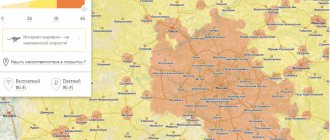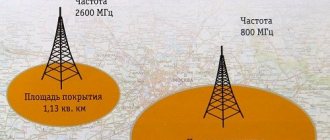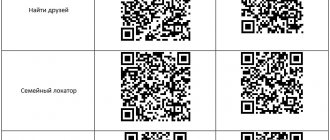Finding base stations with Google Earth Pro
We use Google’s “virtual globe” to search for base stations. Google Earth is known as "Planet Earth". Follow the link and install it on your computer - Google Earth Pro for Windows, Mac or Linux
Let's launch Planet Earth. Carefully, slowly, get acquainted with the information in the “Startup Tips” pop-up window and close it.
We admire our beautiful and vast planet for a few seconds. After that, in the upper left corner, in the search bar, enter the search query we are interested in. In my case, as an example, this is the Novosibirsk region, Moshkovsky district, Kuznetsovka village.
The program is smart, insensitive to the case of letters, so I type the text without capital letters - Kuznetsovka mosh... And “Google Planet” in the search bar gave the desired address. I select it and click on search.
Next, using the mouse wheel, I enlarge the image and find the object of interest. Let it be a local store where you urgently need to install the Internet.
In the toolbar, I click on “Add a label” and give it a name. I press “Ok”.
I chose the default icon for the label, you can choose any one you like. And also add important information for you to the “Description” tab. It will pop up on the map when you click on the icon.
How to find a base station on a map
How to find a base station on a map.
- Introduction
- BS parameters are unknown. Kostroma region
- The parameters of the BS are known. Suburb of Penza
- Conclusion
Introduction
One of the first questions that arises when you are connecting to the mobile Internet is the question of where to locate the base station of your chosen operator so that you can point your antenna towards it. It is advisable to find out the exact coordinates of the tower and the terrain before it in order to understand whether it makes sense to use the tower to receive the signal. Services and various Android applications do not provide exact coordinates of the BS, because based on measurements and their mathematical processing. The error can reach several kilometers.
Often, tower coordinates can be determined by studying operator coverage maps, terrain, Google and Yandex maps, as well as the opportunities they provide to view photographs and panoramas of the area being studied. It must be said that the BS cannot always be found on the map. There can be many reasons for this - the maps are outdated, the BS is located on the roof of the building and is simply not visible on the map, the tower is small, etc.
BS parameters are unknown. Kostroma region
Given: coordinates 57.564243, 41.08345, Kuzminka village in the Kostroma region. The task is to determine the exact coordinates of the BS to which you can connect to receive a 3G signal.
We will consider the search for BS step by step.
Step 1. Analysis of coverage maps.
Let's use the well-known service https://yota-faq.ru/yota-zone-map/, which presents the coverage areas of four operators, except Beeline. I will note here that the Beeline coverage presented on their website is almost impossible to use - as a rule, it shows continuous coverage that does not take into account the terrain.
The coverage areas of Megafon and MTS look the most interesting from a connection point of view. You can see this for yourself by opening the service, inserting coordinates into the search bar and switching operators.
Megafon coverage area:
MTS coverage area:
From the analysis of Megafon's coverage area, we see that 3G BS are most likely located in the directions Krasnoye, Sukhonogovo, Lapino (at this scale the Lapino map is not visible, this is the southwest, approximately where the P-600 mark is).
The MTS coverage area is more interesting. Here we also consider the direction to Sukhonogovo and Krasnoe. But Red is a more interesting option, because... there is 4G coverage there. The distance to Krasny is about 10 km, if MTS distributes 4G at a frequency of 1800 MHz, then there is every chance of establishing communication with one of the MTS BSs located in this locality.
Step 2: Study the terrain.
The terrain up to Krasny is difficult, but quite passable. To assess the terrain, we will use the service https://airlink.ubnt.com. If this is your first time on this site, you will first need to go through a free registration procedure. Having opened the service, scroll the slider down to the end and enter the initial data in the lower right corner, as shown in the following figure.
I usually first enter the same coordinates in both windows, and then start moving the purple mark to the points of interest to me, where the BS could presumably be located. At the same time, the relief, line of sight and the approximate size of the Fresnel zone are displayed in the upper right corner of the screen.
For our coordinates we have:
Checking the terrain in other “suspicious” directions showed that the terrain there is much worse. Thus, we decided on the direction and at the same time chose the operator - MTS.
Step 3. Clarifying our choice using the “Communication Quality” service
The service opens at the following address https://geo.minsvyaz.ru. In the search line, set the name of the village Kuzminka, switch the view from 4 windows to single-window mode, scale the map to a convenient size and get for the MTS operator:
We see that our choice is correct, because according to the measurement database of users of this service, Krasnoye actually has good 4G coverage from MTS.
Let's zoom in on this map and see that the most likely location of the tower (or towers) is Sovetskaya and Okruzhnaya streets.
Step 4. Study the area using Google and Yandex maps.
These maps have a useful tool for studying the area - panoramas and photographs of the area. Google maps have much more panoramas of various areas than Yandex, so you have to use Google more often when looking at panoramas. On the other hand, Yandex has more photos taken in different places, in addition, Yandex maps for Russia are usually more relevant. In this regard, you have to use both services. Google maps and services are used here.
So, we found out that we need to consider two streets in Krasnoye in search of BS. Launch Google maps, enter the approximate coordinates of the street. Sovetskaya (or street name) and we get:
Here the street view mode is turned on, the street we need is highlighted in blue on the map. You can get a panorama of the street by clicking the mouse anywhere on the blue line. Moving in this way along the street to the north, at the post office building we find the first BS:
Moving further, we find the second BS:
And finally, not far from the intersection of Sovetskaya and Okruzhnaya streets, a third tower is discovered, the highest of those found:
We return to the map and find the shadow of this tower in the place where the photo points:
We mark this place on the map with the mouse and get the exact coordinates of the BS:
Let us summarize some of the results of our research. Using information obtained from coverage analysis, user measurements of signal strength in the area of interest, and study of the area through photographs and panoramas, we were able to find three base stations and their exact coordinates in a city we had never been to. The question of which operator owns the found BS remains open, because the answer to this requires additional research. The easiest way is to drive along the route and measure the BS parameters using some Android application that displays MNC, MCC and signal strength. Some of these applications are presented here.
The parameters of the BS are known. Suburb of Penza
As is known, a number of Android applications, as well as a HiLink modem interface and an MDMA program, can provide BS parameters, with the help of which well-known services and applications can provide approximate BS coordinates, which makes it easier to find specific BS coordinates on maps. Reviews of some of these tools are given in the “Useful Materials” section on the Antex website.
Let's look at a specific example from the forum, the example is based on this topic. User coordinates 53.1592536, 44.8728602, selected operators – Iota or Megafon. The following signal parameters were obtained from the modem interface (screenshots posted by the user):
We enter the received BS parameters (LAC, CellID) into the corresponding fields of the well-known service:
And we get the approximate coordinates of the BS and its position on the area map:
We go to Google maps and, using the “panorama” service, move along the P-208 road, for example, to the west.
After some distance we notice a cell tower on the left in the direction of our movement:
We find this place on the map on an enlarged scale and mark the coordinates of the tower:
Real photo of the tower taken by a user from a different angle:
Distance to the tower is approximately 4800 meters:
As can be seen from our research, the error in determining the BS coordinates obtained using the xinit.ru/bs service is very significant - almost 2 km. Such errors are typical for all services based on user measurement databases, but there are no other services available.
Conclusion
The presented technique, based on the use of widely available cartographic tools, does not always, but quite often allows one to find the exact coordinates of the BS. Significant assistance in determining whether a BS belongs to a particular operator is provided by services that provide information on the parameters of the BS and its approximate coordinates. These services are described in detail here, some useful Android applications are here.
Best regards, your dmitryvv
Additional software for searching coordinates
Sometimes, the documentation (SES conclusions) contains the address where the operator’s BS is located. But when you enter these details into Google Earth Pro, sometimes the location is not displayed accurately. I recommend using Double GIS in parallel if your region is included in it.
When searching for BS on the ground using Google Earth Pro maps, sometimes you come across areas with a fuzzy image. In such cases, I use Yandex maps. Often, Yandex has much better pictures.
And at the end of the article, creative advertising for LG HD TV











